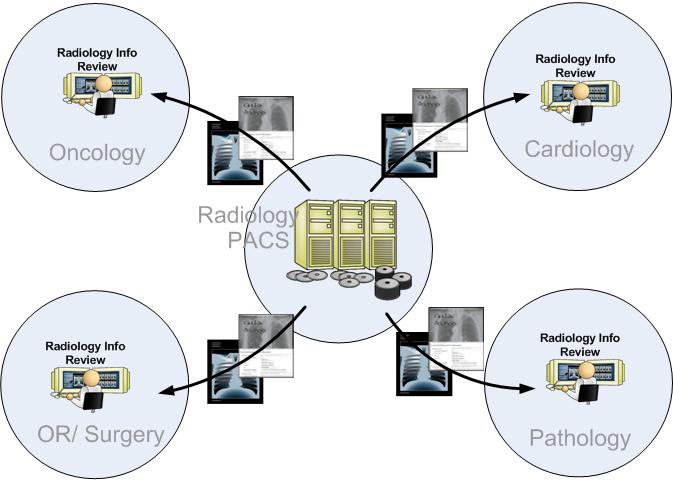Difference between revisions of "Access to Radiology Information"
m (→Benefits) |
|||
| Line 6: | Line 6: | ||
Radiology information (including images and related reports) is accessible within the radiology department and between radiology and other departments within the hospital such as pathology, surgery and oncology. Non-radiology information (such as lab reports) may also be accessed if made available in DICOM format. | Radiology information (including images and related reports) is accessible within the radiology department and between radiology and other departments within the hospital such as pathology, surgery and oncology. Non-radiology information (such as lab reports) may also be accessed if made available in DICOM format. | ||
| − | [[Image:ARI- | + | [[Image:ARI-v4.jpg | Access to Radiology Information]] |
==Benefits== | ==Benefits== | ||
Revision as of 08:03, 25 March 2008
The Access to Radiology Information (ARI) integration profile shares images, diagnostic reports, and related information inside a single network.
Summary
Radiology information (including images and related reports) is accessible within the radiology department and between radiology and other departments within the hospital such as pathology, surgery and oncology. Non-radiology information (such as lab reports) may also be accessed if made available in DICOM format.
Benefits
Reduce Errors and Enhance Patient Care
- Reduces incomplete imaging records because the display provides consolidated access to additional clinically relevant data from other archives (such as the Cardiology PACS, long-term archive, etc.)
Improve Throughput
- Prevents manual searches of multiple systems (Radiology and Cardiology PACS, enterprise archive) for pertinent patient data-the PACS provides a consolidated view of DICOM data from multiple systems
Improve Data Accessibility
- Improves access around the hospital-the PACS supports the query/retrieve of DICOM images and data at viewing workstations
- Improves access to data from multiple PACS-the workstation consolidates query results and accesses data stored on physically separate systems (e.g., ultrasound miniPACS, cardiology PACS, and radiology PACS)
Reduce Deployment Cost/Time
- Prevent custom interface specification time and cost-IHE TF provides detailed specifications for a powerful interface, supported and tested by many vendors
- Prevent custom interface implementation time and cost-many IHE Integration Profiles are already supported by many vendor products
- Reduce interface compliance testing time and cost-many implementation variations have been ironed out in systems tested at IHE Connectathons
- Reduces intersystem testing time and cost-many combinations of systems have already been directly tested together at IHE Connectathons
- Reduces custom interface maintenance time and cost by maintaining a single IHE interface instead of multiple custom interfaces
(NOTE: Some of the benefits mentioned above require systems that support the "Multiple Sources Option" of Access to Radiology Information (ARI) Profile in order for the benefits to be achieved).
Details
The Access to Radiology Information (ARI) Profile allows departments outside Radiology to access the "DICOM-based work products" produced within the Radiology Department. Examples of these work products include: DICOM images, key image notes, presentation states, and radiology measurements or reports encoded as DICOM Structured Reports(SR).
The infomration access is provided via the standard query/ retrieve mechanisms defined by the DICOM standard.
There is also a "Multiple Sources Option" that enhances the ARI profile by describing how DICOM workstations can use the same DICOM mechanisms to access information in multiple PACS systems (e.g., a legacy archive and the current "production PACS") in order to present a more complete picture of the patient's imaging history.
Systems Affected
This profile includes both enterprise-wide and radiology-department imaging and reporting systems such as:
- Review or diagnostics image softcopy display stations (stand-alone or integrated with a HIS, RIS, PACS or Modality) query and retrieve DICOM images and presentation states for display.
- Reporting stations (stand-alone or integrated with a HIS, RIS, PACS or Modality) query and retrieve DICOM images and DICOM SR encoded prior reports.
- Image management and archiving systems (PACS) provide the "source" of the imaging information being queried and retrieved.
- Report repositories (stand-alone or integrated with a HIS, RIS or PACS) provide the "source" of the report information being queried and retrieved.
Actors & Transactions:
Specification
Profile Status: Final Text
Documents:
IHE Radiology Technical Framework:
Underlying Standards:
See Also
Related Profiles
The following profiles describe radiology "content" that can be shared with other, non-radiology departments using the ARI profile:
- Scheduled Workflow [SWF] - for most types of radiology images
- Nuclear Medicine Image [NM] - for NM images
- Mammography Image [MAMMO] - for mammography images
- Evidence Documents [ED] - for radiology measurements and other evidence encoded as DICOM SR (structured reports)
- Simple Image and Numeric Report [SINR] - for radiology reports encoded as DICOM SR
- Key Image Note [KIN] - for key image notes encoded as DICOM Key Object Selection SRs
- Consistent Presentation of Images [CPI] - for DCIOM presentation state objects
The following profile is used to ensure that all content queried and retrieved using ARI has a consistent set of patient demographic information:
The following profiles are other ways to share radiology information outside the radiology department:
- Cross-enterprise Document Sharing for Imaging [XDS-I] - enables the sharing of radiology-produced imaging data outside/ across enterprises.
- Portable Data for Imaging [PDI] - enables the sharing of radiology-produced imaging data using portable media (e.g., CDs)
Consumer Information
The ARI Profile FAQ answers typical questions about what the Profile does.
The ARI Profile Purchasing describes considerations when purchasing equipment to deploy this Profile.
Implementer Information
The ARI Profile Implementation provides additional information about implementing this Profile in software.
This page is based on the Profile Template
